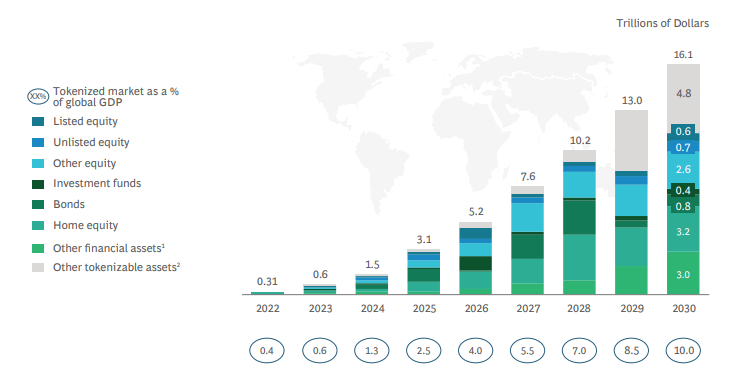Tokenization of illiquid assets to reach $16T by 2030 — Report

The total size of tokenized illiquid assets, including real estate and natural resources could reach $16.1 trillion by 2030, according to the Boston Consulting Group (BCG).
In a newly released report from BCG and digital exchange for private markets ADDX, authors including BCG managing director Sumit Kumar and ADDX co-founder Darius Liu noted that “a large chunk of the world’s wealth today is locked in illiquid assets.”
According to the report, illiquid assets include pre-IPO stocks, real estate, private debt, revenues from small and medium businesses, physical art, exotic beverages, private funds, wholesale bonds, and many more.
Reasons for this asset illiquidity are attributed to factors such as limited affordability for mass investors, lack of wealth manager expertise, limited access — such as when assets are restricted to elite cliques (in the case of fine art and vintage cars), regulatory hurdles, and other scenarios in which users have difficulty acquiring or trading an asset.
On-chain asset tokenization could solve this problem, a market that surpassed $2.3 billion in 2021 and is expected to reach $5.6 billion by 2026, as per the report.
The authors added that in just the last two years, global digital asset daily trading volume has soared from 30 billion euros in 2020 to 150 billion euros in 2022, noting that it «is still minuscule in comparison to the total potential of illiquid tokenizable assets in the world.”
By 2030, the authors forecast the on-chain asset tokenization opportunity to reach $16.1 trillion — made up largely of financial assets (such as insurance policies, pensions, and alternative investments), home equity, and other tokenizable assets, such as infrastructure projects, car fleets, and patents.

Tokenization of global illiquid assets by 2030. Source: Boston Consulting Group
The authors also noted that this was a “highly-conservative forecast” and that in a best-case scenario, the tokenization of global illiquid assets could reach $68 trillion.
However, the potential of tokenized assets will differ across countries due to various regulatory frameworks and asset class sizes.
In Singapore, the Monetary Authority recently launched the Project Guardian, a blockchain-based asset tokenization pilot that will explore decentralized finance (DeFi) applications in wholesale funding markets by establishing a liquidity pool of tokenized bonds and deposits to execute borrowing and lending processes on-chain.
In addition to Singapore, tokens issuance is regulated in Hong Kong, Japan, the European Union, the United Kingdom, the United States, the United Arab Emirates, Germany, Austria, and Switzerland.
Other authors in the report include BCG’s project leader Rajaram Suresh, associate director Bernhard Kronfellner, and consultant for BCG Aaditya Kaul, noting:
“On-chain asset tokenization presents an opportunity to obviate many of these barriers of asset illiquidity as well as the current modality of traditional fractionalization.”
Real estate may be among the illiquid assets that could benefit from tokenization, with investors looking for investments backed by real-world assets in DeFi.
Cointelegraph Research Terminal revealed that real estate assets account for upwards of 40% of the pipeline for certain technology providers, making it one of the primary sectors for security token offerings.
Earlier this month, the digital asset investment platform Zerocap announced that companies on the Australian Securities Exchange (ASX) could be able to trade tokenized bonds, equities, funds, or carbon credits after a successful proof-of-concept trial.






 Bitcoin
Bitcoin  Ethereum
Ethereum  Tether
Tether  USDC
USDC  Dogecoin
Dogecoin  TRON
TRON  Cardano
Cardano  Chainlink
Chainlink  Stellar
Stellar  Bitcoin Cash
Bitcoin Cash  Hedera
Hedera  LEO Token
LEO Token  Litecoin
Litecoin  Monero
Monero  Dai
Dai  Cronos
Cronos  OKB
OKB  Ethereum Classic
Ethereum Classic  Cosmos Hub
Cosmos Hub  VeChain
VeChain  Algorand
Algorand  Gate
Gate  KuCoin
KuCoin  Stacks
Stacks  Tether Gold
Tether Gold  Theta Network
Theta Network  IOTA
IOTA  Zcash
Zcash  Tezos
Tezos  TrueUSD
TrueUSD  NEO
NEO  Polygon
Polygon  Decred
Decred  Dash
Dash  Qtum
Qtum  Zilliqa
Zilliqa  Synthetix Network
Synthetix Network  Ravencoin
Ravencoin  Basic Attention
Basic Attention  0x Protocol
0x Protocol  Siacoin
Siacoin  Holo
Holo  DigiByte
DigiByte  Enjin Coin
Enjin Coin  Ontology
Ontology  Nano
Nano  Status
Status  Hive
Hive  Waves
Waves  Lisk
Lisk  Steem
Steem  Pax Dollar
Pax Dollar  Numeraire
Numeraire  BUSD
BUSD  Huobi
Huobi  OMG Network
OMG Network  NEM
NEM  Bitcoin Gold
Bitcoin Gold  Ren
Ren  Bitcoin Diamond
Bitcoin Diamond